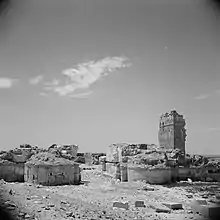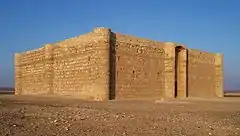Qasr al-Hayr al-Gharbi
Qasr al-Hayr al-Gharbi (Arabic: قصر الحير الغربي) is a Syrian desert castle or qasr located 80 km south-west of Palmyra on the Damascus road. The castle is a twin palace of Qasr al-Hayr al-Sharqi, built by the Umayyad caliph Hisham ibn Abd al-Malik in 727 CE. It was built in the Byzantine architectural style.
| Qasr al-Hayr al-Gharbi قصر الحير الغربي | |
|---|---|
 Qasr al-Heer al-Gharbi facade | |
 Location within Syria | |
| General information | |
| Town or city | Homs Governorate |
| Country | Syria |
| Coordinates | 34.374444°N 37.605833°E |
Description

Qasr al-Hayr al-Gharbi is one of a number of desert castles in the Syrian/Jordanian region. The site originally consisted of a palace complex, a bath house, industrial buildings for the production of olive oil, an irrigated garden and another building which scholars suggest may have been a caravanserai. Over the entrance is an inscription which declares that the it was built by Hisham in the year 727, a claim that is borne out by the architectural style.[1]
It was used as an eye of the king during the Umayyad era, to control the movement of the desert tribes and to act as a barrier against marauding tribes, as well as serving a hunting lodge. It is one of the most luxurious examples of a desert palace.[2] Later it was utilized by the Ayyubids and the Mamelukes but was abandoned permanently after the Mongol invasions.
The castle is quadrangular in outline with 70-meter sides. The central doorway to the castle is very attractive, and has been moved to the National Museum of Damascus to be used as the entrance. Its semi-cylindrical towers on the sides of the doorway, columns, and the geometric shapes mirrored a blend of Persian, Byzantine and Arab architecture.[3]
Little of the original castle remains; however the reservoir to collect water from Harbaka dam, a bath and a khan are still visible. The gateway is preserved as a façade in the National Museum of Damascus.
See also
References
- Fowden, G., Qusayr 'Amra: Art and the Umayyad Elite in Late Antique Syria, University of California Press, 2004 p. 157
- Petersen, A., Dictionary of Islamic Architecture, Routledge, 2002 , p. 238
- Brend, B., Islamic Art, Harvard University Press, 1991, pp 24-26

